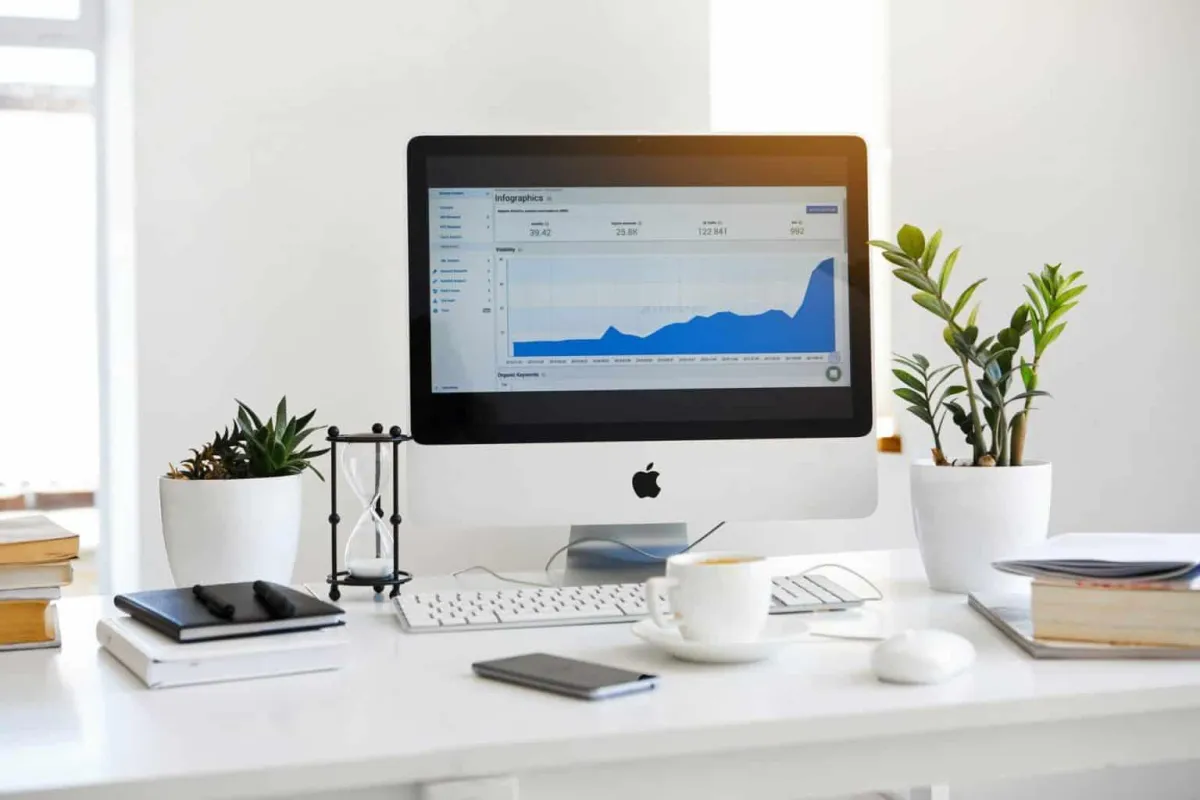TO LEARN IS TO GROW
Learning Center
We do our research and publish our results. Should probably call this the Growing Center.


Maximizing Your Work From Home Tools (To Actually Help You Get Work Done)
Even before the pandemic, remote work has been on the rise. Let’s have a look at the most essential work-from-home tools you need to get the job done, and what you need to do to keep your work setup at home as productive as possible.
As we transition to the new normal, more people find themselves working from home. Companies, that are not considered frontline businesses, are in the process of shifting to a work from home arrangement to help curb the spread of coronavirus.
In a crucial time like this, being highly adaptive and equipped with the right work-from-home tools are key ingredients for both companies and workers to survive and succeed.
Now it looks like working-from-home is now part of the new normal. Even when we all get through this pandemic, most folks– now that they’ve experienced the work-from-home lifestyle– would prefer to continue doing so.
For starters, studies have revealed that, yes, working from home has shown to be even more productive than regular office work.
Work-from-home employees tend to be generally happier as well (although job satisfaction still varies from industry to industry).
Now of course, it isn’t all peaches and cream with working from home:
Some folks miss or prefer the more social work environment at an office.
Others see going to work (at an office) as a way to escape regular family life
While others see working at an office as a sign of involvement and commitment that can result in better career or growth opportunities.
Still, working from home has been the norm now. An optimized remote work setup with the right work-from-home tools can truly get you far in this brave new world.
Whether this work arrangement is new or has been in place for a long time, you can take note of these tips to make work smarter and more efficient.
The Right Work-From-Home Tools
Just because you are working from home means you are detached from the world. Collaboration is ever-present, even in work from home arrangement. Make sure that you are equipped with the right tools to make this happen.
Download video conferencing, chat, and team collaboration apps to help with the smooth flow of communication within your team.
The new normal may require us to distance ourselves from other people to keep everyone safe, but it doesn’t necessarily mean that our relationships with our teammates and officemates have to end.

1. Wireless Keyboard
Eric Eckel, a writer at TechRepublic, opened up about how using wireless keyboards can prove to be advantageous in a work-from-home environment.
Not everyone can set up an office or an isolated working space to use at home. Now that everyone is being forced to work remotely, portability becomes a necessity in choosing office tools because you need to be able to bring your things with you around the house as you try to find a place to work.
A wireless keyboard can be used anywhere in the house as long as you can still send its radio signals to communicate with the adapter. You can work while placing the keyboard on your lap, on your bed, or you can carry it and type on it while moving around the house.
Wireless keyboards are an excellent choice for people working at home because it allows the user to adjust and continue to work in whichever way is most convenient to him.

2. Wireless Mouse
In the same logic as the wireless keyboard, going cordless with your mouse can help you work more efficiently by not compromising your mobility.
You don’t need to sit next to the computer as you use your wireless mouse, and you won’t have to worry about fixing a tangled cord ever again.
A wireless mouse also functions better because there’s no cord to get in the way of its movement.
How many times have you tried to move the mouse only to run it over the cord and have your cursor get lost on the screen? Not to mention it takes up a lot less space because there are no wires connecting it with your computer.

3. A Reliable Desktop or Laptop
A common issue encountered by many work-from-home individuals is the inferiority of their machinery at home.
Some are fortunate enough to receive computers from their employers, while some have to get by on their own resources.
If you are part of the latter group, consider investing in a good quality laptop. Find a model that is best suited for your role at work. Chances are, work from home arrangement is here to stay. This investment is the wisest thing you can do to secure your job or further your career.
Aside from the computer, you also need to guarantee that you have access to a stable, fast, and reliable internet connection. In some countries, fast internet might be a little steep in price.
However, you should consider the amount you are saving from not commuting or paying for gas and parking. You can also ask your manager or employer if there is an option to avail yourself of an internet allowance to ensure you can deliver your work at the time it is needed.

4. Docking Station
When you have worked on a desktop for a long time, suddenly switching to a laptop because you’re forced to work from home can be very challenging.
By using a docking station, you can essentially turn your laptop into a desktop by being able to plug in multiple accessories simultaneously.
Laptops usually don’t have more than two USB ports. A docking station fixes that by providing multiple ports for your peripherals to connect to.
With a docking station, you can work on your laptop while staying connected to the printer, panel monitor, digital camera, and other accessories that were not possible to use on laptops before.

5. Your Dedicated Workspace
Your brain associates your home to comfort and relaxation. In some cases, it might be hard for you to focus and be productive because of your home ambiance.
One effective way to combat this phenomenon is to set up a designated workspace. Allow your brain to compartmentalize different parts of your home into spaces of different purposes.
At the very least, you’ll want to have:
A sturdy and comfortable chair
A just-as-sturdy desk with enough space for all your stuff
Adequate lighting
Enough sockets nearby for power
Convenient storage areas

6. Apps and Other Tools
Use technology to your advantage when you can. Some of the most indispensable work-from-home tools come in the way of applications, software, online services, or other cool gear.
Teleconferencing apps such as Zoom, Skype, Google Meet, (as well as a host of many others) have made online collaboration and communication among team members so much easier.
Other tools we’ve used working from home might include:
Other online collaboration services such as Google Docs, Slack, Canva, and more
Project management software such as Trello, Basecamp, Asana, and others
Various apps for productivity on both Google Play and the App Store
Marketing automation software and CRMs
Noise cancellation headsets to help focusing
How Do I Optimize My Workspace at Home?
Even though you’re working at home, you can still feel uncomfortable in your makeshift office setup if your desk isn’t optimized for you. Without proper office ergonomics, you can be prone to neck and back pains as well as sore arms and wrists.
When your desk and chair were manufactured, the makers didn’t tailor it for a specific individual. Instead, they were thinking of a general population that can use it, which explains why the factory model isn’t always comfortable for everyone.
Ergonomics expert Jon Cinkay from the Hospital for Special Surgery gave the following pointers to help you customize your office equipment and have it better suited to your comfort.

1. Adjust your Chair
Ideally, your chair should support your spinal curves so that you won’t feel muscle pain after sitting in the position for hours.
You need to adjust the chair’s height so it can better support your back. Balance yourself on the chair and adjust until your feet are resting flat on the floor. If you’re too small for the chair, you can use a footrest.
Next, your elbows should be bent at a 90-degree angle as your arms take the armrests. If your shoulders are relaxed and your arms don’t feel pressure in your position, you’re probably doing it right,
2. Adjust the Monitor, too
The monitor should always be directly in front of you, at about an arm’s length away. Make sure that the top of the screen is at your eye level to prevent eye strain. If you use two monitors and you need to see both screens at the same time, line them up in such a way that your vision is in squarely in the middle.
If you use a laptop or a monitor with no adjustment features, you can utilize a kickstand or a stack of paper to support the monitor as you align it with your eye level.

3. Mind Your Mouse and Your Keyboard
To avoid having sore arms and wrists, maintain a distance from your desk such that your hands always end up where your keyboard should be. The mouse should be right next to your keyboard so you won’t have to reach.
The goal is to move your elbow instead when you need to reach for something instead of using your shoulders. Shoulders are prone to strain injuries when it overextends as you try to reach something far away.
4. Move from Time to Time
After ten to fifteen minutes of sitting in the same position, we have a tendency to start slouching. Slouching extensively can hurt your back in the long run. To prevent inactivity that leads to slouching, you can try to do some easy exercises while sitting.
You can start off with a chin tuck. Next, you can stretch your head from one side to another, and gently pull towards the direction your head is pointing, 10, 15 minutes, we all begin to slouch in our chairs. These exercises can help you readjust your neck muscles.
You also need to exercise your lower back muscles and your shoulders from time to time. Squeeze your shoulders back as you sit and hold it in that position for at least ten seconds. To exercise your back, it’s best to get up and walk for at least five minutes to help it free up contracted muscles from sitting all day long.
5. Other Tips To Make The Most of Your Home Workspace
Avoid working in areas where you rest and eat.
If you can, design your workspace differently than the other parts of the house.
Paint the room with a different color, or place your office table in a far corner.
Create a visual stimulus for you to associate that specific space to work-related matters only.
How Do I Properly Keep My Laptop Clean (and in Good Working Order)?
Having a laptop (or desktop) is one thing. Keeping it in perfect running order is another thing entirely.
Especially when keeping your workspace clean and sanitized is a much more serious matter these days, you’re also now expected to do some cleaning on your work machine as part of your routine maintenance.
Of all your work-from-home tools, your computer is probably the most important piece of equipment there is, so here’s a quick step-by-step guide to cleaning and sanitizing your laptop or desktop.

1. First Things First: Cleaning the Outside
First, you have to make sure that your unit is unplugged. Second, if you have a removable battery, gently take it out and set it aside, just to be on the safe side.
Take note that the outside of your laptop is equally as important as the inside, so it’s necessary to clean that as well.
For this, you would be needing the following:
dishwashing liquid,
warm water,
a bowl,
and a lint-free cloth.
Set the bowl in a spot away from the laptop, then mix a couple of drops of the dishwashing liquid with a few cups of warm water.
Take your lint-free cloth, dip it in the mixture, and wring it out. Make sure it isn’t too wet, and then you can go ahead and wipe the outside of your laptop.
For deeper cleaning, rinse out your lint-free cloth, wring it out and do a rubdown again. Once you’re satisfied, get a dry cloth and wipe the outside one last time.

2. Cleaning your Laptop Screen
The same mixture can be used to clean your laptop screen. A dry cloth is okay, but a microfiber cloth is preferred.
Dip the microfiber cloth into the bowl, wring it out, then use that to wipe your laptop screen softly. Remember to refrain from rubbing too hard as it might damage your screen.
To be sure that there’s no soap residue, wash your microfiber cloth for the second time and give your laptop screen another rubdown.
Lastly, take your dry cloth and wipe your screen to get rid of any streaking.

3. Keyboard and Ports Cleanup
Because the keyboard is the part of your laptop that you touch the most, it’s also the most filthy part.
You would need the following for this:
lint-free cloth,
rubbing alcohol,
trash can,
and a compressed air blower.
The first step is to shake your laptop on top of a trash can to remove everything stuck inside.
Secondly, get your air blower and gently use it to clean your keyboard. A plus to this is that it doesn’t contain any chemicals, and the brush attachment can get the dirt in between your keys.
Lastly, grab your lint-free cloth, dip it into some rubbing alcohol, and give your keyboard a rubdown.
As for your laptop’s ports and vents, use an air blowing device to clean those up.
For more thorough cleaning, you can always remove the case of your device but make sure you look at the user manual before doing so. After all these steps, your laptop is ready to be plugged in!

What Can I Do To Make My Work-From-Home Setup More Productive?
The pandemic has forced us to rethink the way we work. From the usual office set-up and conference rooms, we have shifted to home offices and Zoom meetings.
Working from home is extremely difficult for many people, especially working people who have to manage households and take care of their families simultaneously.
A significant number of people complain that working from home brings a lot of distraction. To this, we agree.
However, there are a lot of solutions out there to eliminate this problem.
It takes discipline to succeed in a work from home arrangement. You may spend a couple of workdays uneasy and unable to focus, but with the right mindset coupled with the right tools, you’ll master working from home in no time!

Here are seven steps to engineer a more conducive work-from-home environment to encourage better productivity and minimize stress:
1. Make use of underutilized areas in your home.
People complain about not having a designated workspace in their homes. Most homes are not set up to have a home office. Re-imagining the purpose of the areas in your house is a great first step.
Desperate times call for desperate measures. You need to lower your standards when it comes to your expectation of a workspace. The important thing is to have a designated area where you can work. It does not have to be a traditional office table and chair. It can be your walk-in closet, your car, your garage.
2. Create sensory isolation.
Seeing and hearing everything is counterintuitive. You might want to monitor your kids all day. You might want to watch laundry while you’re working. But don’t!
A great way to focus is to create sensory isolation. Block sounds by putting earplugs and earphones. Create a visual division by facing a wall or the windows.
3. Set up boundaries.
Most of the family stay all day in the house. With your loved ones staying in the same space as you, it is easy to be distracted by someone asking you a question or calling your attention. You can avoid this by putting up “Do not disturb” signs in your work area.
It is also vital that you communicate with your housemates. Let them know your schedule so that they will not bother you in hours when you need to focus on your work.

4. Compartmentalize your time.
Another common problem that people encounter is having to manage the household and work at the same time.
To this, we say: compartmentalize!
Multi-tasking housework and office work are not doing you any good. Your brain needs to focus on one thing to get the job done quickly and correctly. Set a day for doing the laundry or cleaning the house. Don’t do everything at the same time.
5. Plan a new schedule.
This new world means new lifestyles. Your old routine may not work in the new normal. Plan a new schedule that you can do with your housemates. Someone can take the day shift; another one can take the night shift. Letting each other know what schedule for you is a great way to avoid tension and fatigue.
6. Teamwork makes the dream work.
Cooperative action is the key to successfully transitioning to work from home. It is time to act like a real tribe. Share responsibility with everyone in your family. Assign duties to each member, so the load becomes lighter.
7. Educate.
Teach the importance of focus. Focus can be really difficult to achieve when living in a world distracted by social media and personal devices. But now is the best time to learn it. Start by teaching them how to focus for short periods, then build it up to longer ones. When everyone else focuses on the things that they have to do, it is easier for you to focus as well.
A Final Word About Your Work-From-Home Tools
Preparing yourself to be remote work-ready has never been easier with the plethora of work-from-home tools, and time management/productivity apps.
Your tools and gear are just one part of the entire setup. Optimizing your workspace and making sure you’re in the proper headspace to get work done is just as important.
If you want to go a more traditional route in solving this issue, you can tune in to some classical music with a headset to set the tone when you are working. You can also meditate for a short while before working. When you feel overwhelmed, remember to take breaks as well, as you would in your traditional office.
Now that you have the tools to engineer a work from home environment, it is time to see if it works for you!
Built for Growth. Backed by 25 Years of Trust.
For over two decades, LOJO has been a trusted partner to hundreds of businesses just like yours. Whether working directly with owners, managers, teams, or boards of directors, our goal remains the same: to be a reliable and results-driven asset to your business.
Over the years, we’ve carefully built a team of experts—each selected for their unique skills, strengths, and personalities. Our clients choose LOJO because they know we genuinely care about their success.
And after 25 years of helping businesses grow, we’re more committed than ever.


Built for Growth. Backed by 25 Years of Trust.
For over two decades, LOJO has been a trusted partner to hundreds of businesses just like yours. Whether working directly with owners, managers, teams, or boards of directors, our goal remains the same: to be a reliable and results-driven asset to your business.
Over the years, we’ve carefully built a team of experts—each selected for their unique skills, strengths, and personalities. Our clients choose LOJO because they know we genuinely care about their success.
And after 25 years of helping businesses grow, we’re more committed than ever.




Matthew Rogers, President
iProspect Check
After spending several months reviewing multiple proposals from several different companies we engaged LOJO to develop a new website that represents our company effectively. We worked initially with Stephen Platte who helped create the scope of the project. Stephen was knowledgeable and always followed up with me on time and as promised.
He "closed the deal" for LOJO with his professionalism, service orientation and easy going approach. Once we signed the contract we were introduced to Jay Kelly who would be the creative lead for LOJO. This was the most challenging part of the project for my company, as there was no shortage of ideas from our side. Jay managed the project flawlessly, and once we had all agreed to the design, Jay introduced us to Eric.
Eric Lay is one of the founders of LOJO. Eric took the design we had developed and brought it to life. We delivered content as quickly as he requested it. Eric kept the project on task and we responded by exceeding every deadline for content. In turn, once provided, literally not a day went by that Eric didn't add the content and take the next step. In just a few weeks we launched our new website. Eric is a pleasure to work with.
His positive attitude and consultative approach really enhanced the experience and made a big difference for us in the outcome of our project. We would welcome you to visit our website to take a look at the quality work of LOJO. We are very pleased with LOJO and look forward to working with them in the future as we pursue an aggressive SEO strategy."
After spending several months reviewing multiple proposals from several different companies we engaged LOJO to develop a new website that represents our company effectively. We worked initially with Stephen Platte who helped create the scope of the project. Stephen was knowledgeable and always followed up with me on time and as promised.
He "closed the deal" for LOJO with his professionalism, service orientation and easy going approach. Once we signed the contract we were introduced to Jay Kelly who would be the creative lead for LOJO. This was the most challenging part of the project for my company, as there was no shortage of ideas from our side. Jay managed the project flawlessly, and once we had all agreed to the design, Jay introduced us to Eric.
Eric Lay is one of the founders of LOJO. Eric took the design we had developed and brought it to life. We delivered content as quickly as he requested it. Eric kept the project on task and we responded by exceeding every deadline for content. In turn, once provided, literally not a day went by that Eric didn't add the content and take the next step. In just a few weeks we launched our new website. Eric is a pleasure to work with.
His positive attitude and consultative approach really enhanced the experience and made a big difference for us in the outcome of our project. We would welcome you to visit our website to take a look at the quality work of LOJO. We are very pleased with LOJO and look forward to working with them in the future as we pursue an aggressive SEO strategy."

Matthew Rogers, President
iProspect Check
The team at LOJO were wonderful to work with. They are well organized and very patient as we worked through our marketing strategy and developed a well thought out and clear action plan at a reasonable price. We will definitely be back for our future campaign needs."

Jon Crosby, Founder
Dazil

